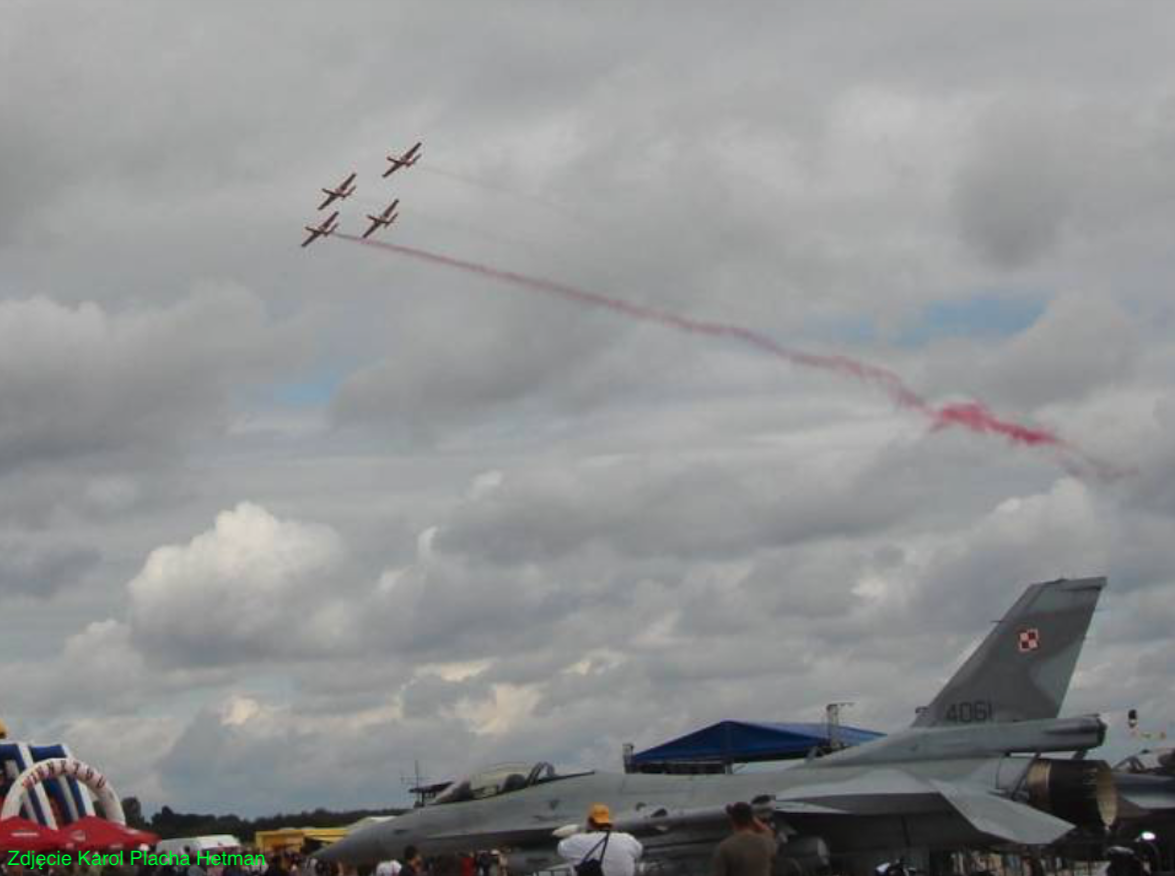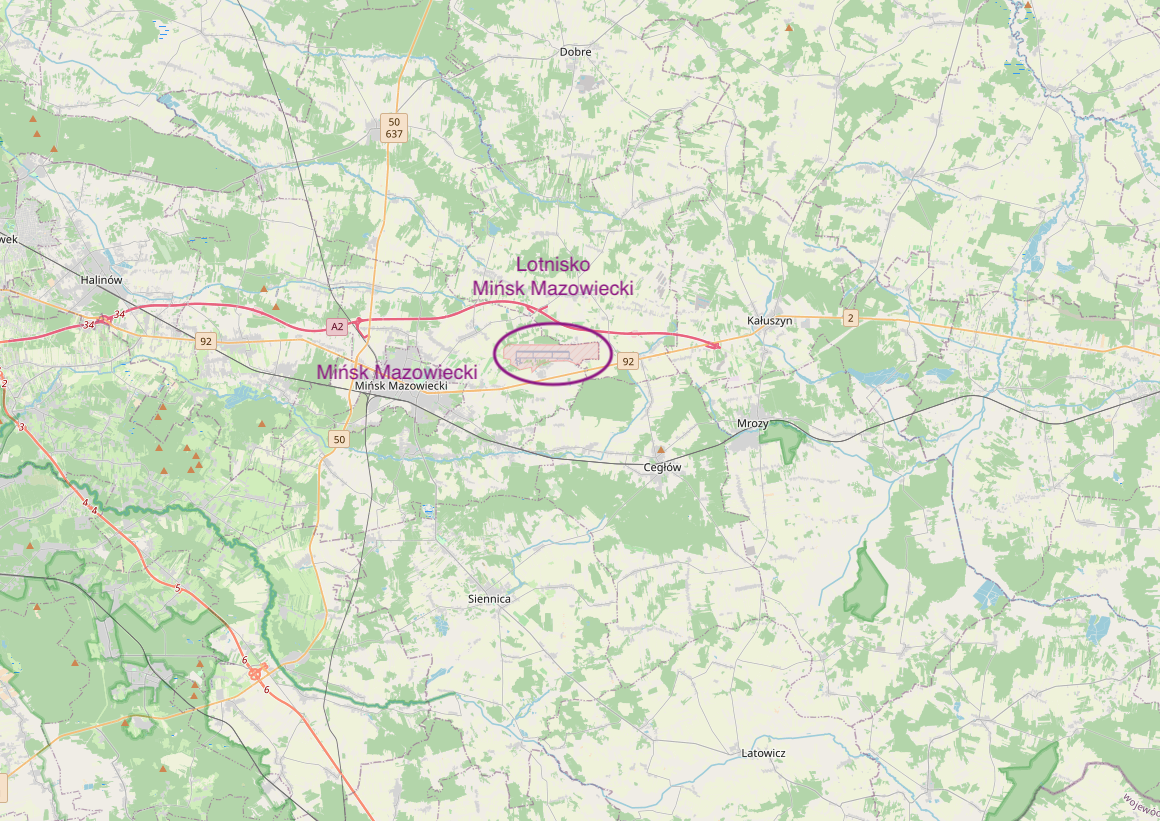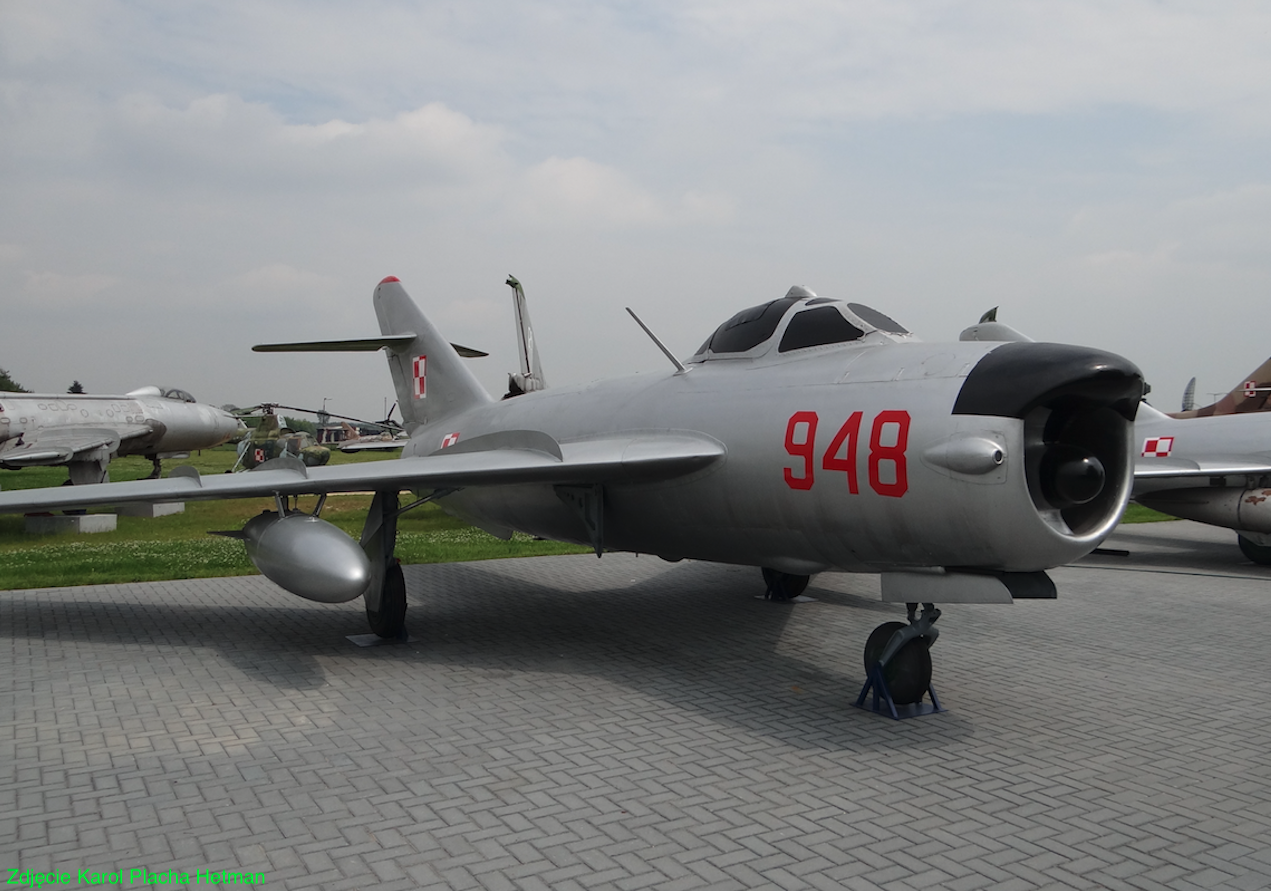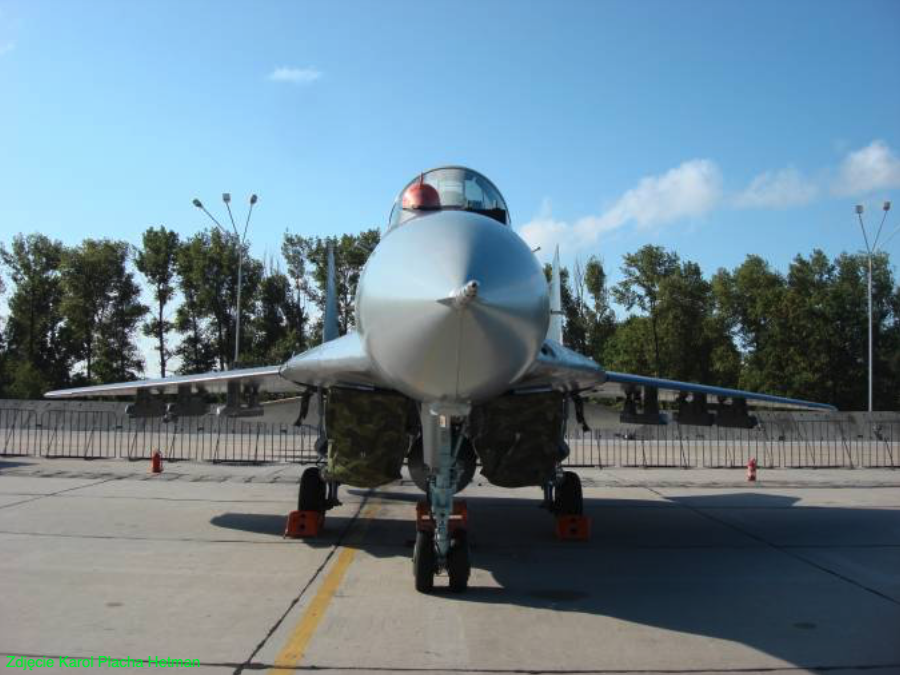Mińsk Mazowiecki 2009-01-09
Mińsk Mazowiecki Airport.
Geographic coordinates: 52.195N 21.657E. Elevation 168 m.


History of the city of Mińsk Mazowiecki.
The history of Mińsk Mazowiecki dates back over 600 years. From May 29, 1421, the town had city rights. The name Mińsk comes from the Mieni River, the etymology of which is in turn related to the word "mienić". The adjective "Mazowiecki" is intended to distinguish the city from Minsk in Belarus. The city changed its name several times during its history (in the Middle Ages, this was due to the development of the Polish language rather than specific changes). Initially, the settlement was called variously - Mieńsk, Mensk and Mińsk. This name survived until 1868, when the Muscovites changed it to Nowomińsk. The current name was given to the city on July 7, 1916. The officially accepted abbreviation is Mińsk Maz. Residents also use MMz. It is also the official abbreviation of the name of the railway station.
City rights were granted to the town by the Masovian prince Janusz I the Elder, and the first owner of the town was Jan of Gościeńczyce of the Prus III coat of arms. The parish was founded in 1422, and the church was built at the Old Market Square.
The peaceful development of the Republic of Poland and Mińsk Mazowiecki was interrupted by the Swedish Deluge. The Swedes burned the city and murdered many of the inhabitants. After the third partition of Poland, in 1816, Mińsk Mazowiecki became the capital of the Stanisławów Oblast. During the November Uprising and the January Uprising, the area around Mińsk Mazowiecki was the site of numerous fights with the occupier. In 1867, the entire Warsaw-Terespol railway line was put into operation.
In 1918, the Polish authorities returned to the city. During the Polish-Bolshevik War, after the victorious Battle of Warsaw on August 17, 1920, Polish forces united here and marched east. The 7th Lublin Uhlan Regiment, which fought heroically in the defensive war of 1939, was stationed in the city. During World War II, the Home Army and the People's Guard conducted sabotage activities in Mińsk Mazowiecki. After the Germanic soldiers left the city, the Home Army took control of it on July 30, 1944, but the next day (July 31, 1944) the Muscovites entered and a new occupation began. On the night of March 2-3, 1945, the NKVD murdered 7 representatives of the Minsk elite, including mayor Hipolit Konopka. In 1945, the city had only 10,500 inhabitants, mainly women and elderly people.
On June 1, 1974, after the administrative reform, Mińsk Mazowiecki became part of the Siedlce Voivodeship. In 1984, Mińsk Mazowiecki was expanded to include the towns of Kędziarki and Anielina. After the administrative reform in 1999, the city became part of the Masovian Voivodeship.
City of Mińsk Mazowiecki.
The city is located 40 km from the center of Warsaw, in the Masovian Voivodeship and is part of the Warsaw agglomeration. The city is the seat of an urban-rural commune. In 2008, Mińsk Mazowiecki was inhabited by 38,181 people. The city is an important commercial, service and industrial center. Mińsk Mazowiecki has a higher school and 6 secondary schools. In Minsk, there are several buildings included in the list of monuments and entire development areas protected by the spatial development plan. The coat of arms of Mińsk Mazowiecki is Leliwa, and the patron saint is John the Baptist.
Mińsk Mazowiecki is located on the Kashubian Plateau in the eastern part of the Masovian Voivodeship. Geographically, it is the South-Podlasie Lowland, and historically and culturally, it is Masovia.
National Road No. 2 (Świecko-Terespol) runs parallel to the road, and in the north-south direction National Road No. 50 (Ciechanów-Ostrów Mazowiecka, the transit bypass of Warsaw), and Provincial Road No. 802 (to Seroczyn near Stoczek Łukowski). The road distance to Lublin is 140 km, to Brest 162 km and to Białystok 180 km. In 2008, the design of the section of the A2 motorway constituting the northern bypass of the city was completed. Construction began on August 24, 2009.
The city is an important railway junction, on the Warsaw-Siedlce direction and on the Tłuszcz-Pilawa direction. The first of them is the E20 railway line (Berlin-Warsaw-Terespol-Moscow). Most trains go to Warsaw (6 express trains, 40 passenger trains to the center and 1 passenger train to Warsaw East) and Siedlce (6 express trains and 20 passenger trains). The farthest connection is to Moscow. Trains that do not stop here also pass through Mińsk Mazowiecki.
History of Mińsk Mazowiecki – Janów Airport.
There is little information about the airport in the first period of its existence. It is known that the airport was used during World War II and immediately after its end. But its poor infrastructure meant that the airport was almost forgotten. At the beginning of the 50s of the 20th century, as a result of the Korean War, dictator Stalin decided to significantly develop Polish Aviation, beyond our needs and capabilities. In a hugely destroyed country, where the main goal was to consolidate the people's power. The number of planes in military units increased from day to day. New regiments were formed and new airfields were built. It was at this moment that Mińsk Mazowiecki Airport was remembered. The decision was made to expand it. A new, concrete RWY and DK, as well as individual aircraft parking areas, were built. Until then, RWY was only dirt and grass. A fuel depot and an ammunition depot were built. Barracks were built for the soldiers.
In 1956, a decision was made to transfer the 1st PLM Warszawa and the 21st Independent Pursuit Squadron to Mińsk Mazowiecki. In July 1957, the Regiment was finally transferred to the airport in Janów near Mińsk Mazowiecki. The Regiment's staff, and especially the conscript soldiers, had to spend many weeks cleaning the area and building internal roads and sidewalks.
The airport has its own specificity. It results from an important road route running almost behind the fence, and an even more important railway route a little further away. The airport was not hidden among dense forests like most others. No specific forest garrison system was developed. The staff could live in Warsaw itself, and conscript soldiers could spend each leave in the capital. The army did not make life too difficult for the local residents either. The numerous villages around the airport, including numerous farms, have never been at such a high risk of displacement as in other cases.
In 1957, the 1st PLM had Lim-1/2 fighters and the first Lim-5 planes, and the 21st SEP had 12 MiG-17 PF planes. These planes had on-board radar sights that ensured the interception of targets in all weather conditions, day and night. But already in 1957, the 21st Independent Fighter Squadron was incorporated into the structures of the 1st PLM and ceased to exist as an independent unit.
In April 1960, a number of (4) Lim-5 P fighters were added to the Regiment's inventory. The equivalent of the Soviet MiG-17 PF. In July 1960, these and other planes from the Regiment took part in an air parade over the fields of Grunwald.

In 1961, Mińsk Mazowiecki Airport became the venue for the first demonstration of Soviet MiG-21s for Polish officers. The short distance from Warsaw made Mińsk Mazowiecki Airport a good place to invite delegations from the Warsaw Pact bloc. The first MiG-21 supersonic planes arrived in Mińsk Mazowiecki in mid-September 1963, almost simultaneously with the 62nd PLM and 11th PLM. These were 6 MiG-21 F-13 units, which were registered with the 1st Squadron.
In 1964, the Regiment in Mińsk Mazowiecki received the first MiG-21 PF machines, equipped with RP-21 radar stations. By the end of 1964, the Regiment had 8 MiG-21 PF units in stock. These aircraft replaced the MiG-17 PF and MiG-21 F-13 previously used in the regiment, which were transferred to other units. Thanks to the rotation of equipment, mainly from the 11th PLM in 1965, the 1st Squadron of the 1st PLM had 12 MiG-21 PF and 2 MiG-21 U.
On June 30, 1966, a MiG-21 PF nb 2405 No. 762405 of 1 PLM suffered an accident. Pilot Lieutenant Władysław Betka died. The surroundings of Olszyna. The flight was performed by a pair of planes. Władysław Betka was led. While passing through the clouds, the pilot lost sight of the leader. According to the procedure, he should move to the right to avoid a collision. However, the pilot lost spatial orientation and the plane crashed. The pilot tried to eject, but due to the low altitude, the parachute did not deploy.
As it turned out, MiG-21 PF aircraft stayed in the Regiment for an extremely long time, until 1989, when they were replaced by MiG-21 M from the liquidated Regiment from Goleniów. On May 15, 1966, the Regiment was reformed into a new position No. 6/461, resulting in the creation of the 22nd Flight Command Squadron and the 56th Security Battalion. In 1966, the Regiment, together with pilots from the 3rd PLM, as part of the celebration of the 1000th anniversary of Poland, formed a group called Grot-Centrum consisting of 16 MiG-21 PF machines. In 1968, designated crews of the Regiment engaged in guided missile firefights at the CCCP training ground. In January 1971, a batch of 10 MiG-21 PF aircraft from the disbanded 13th PLM in Łęczyca was accepted into service. In the fall of 1971, aviation competitions were resumed at the airport in Mińsk Mazowiecki, this time for the title of Air Combat Champion. In the 1960s and 1970s, the unit was transferred several times to the reserve Szczytno-Szymany Airport due to the renovation of the airport. At the end of the 70s, the Regiment took over 11 MiG-21 PF aircraft from the 39th PLM. Then in 1982, another 6 MiG-21 PF from other units. In 1988, as a result of the disbandment of the 39th PLM, all remaining MiG-21 PF aircraft were taken over by the 1st PLM, which thus had 36 MiG-21 PF and 7 MiG-21 U in stock. In the following years, the 2nd Squadron appeared MiG-21 M, PFM, because the 1st Squadron received MiG-29 fighters, and MiG-21 PF aircraft in 1989 were canceled.
The second half of the 1980s marked the beginning of a major crisis in the air force, the end of which was still in sight in 2000. In these conditions, it was decided to at least slightly improve this state of affairs and Poland decided to purchase a minimum number of the only MiG-29 battlefield (frontline) fighters available to us.

Another 5 MiG-29 (9.12 A) units arrived in Poland on October 2, 1990. Serial numbers; 26365, 26367, 26383, 26389, (?). They were piloted by Soviet pilots. They were accompanied by an An-12 plane with a technical team. Only it had the right to operate the planes until they were officially handed over to the Polish side on October 30, 1990. The planes were brand new and equipped with an RS-2 M radar station.
In total, these 12 machines allowed the 1st Squadron to be rearmed, but they were a symbolic force and could not re-evaluate the military potential. The 2nd Squadron was equipped with MiG-21 M aircraft based from Goleniów, replacing the MiG-21 PF.
On January 13, 1992, after almost 3 years of basic and tactical training, the 1st squadron of the 1st PLM "Warszawa" from Mińsk Mazowiecki began duty in the Polish air defense system. Due to the critical location of Mińsk Mazowiecki, as the closest base to the eastern border, and the lack of warning means over the eastern border, the MiG-29s were placed on duty in a manner unusual for Polish Air Force regiments, i.e., they were ready to take off 24 hours a day. The Sejm of the Republic of Poland demanded such a decision.
Over a 3-year period, several live firing exercises with cannons and missiles were carried out at the Ustka naval training ground. The introduction of new aircraft coincided with social and political changes in Poland. Thanks to this, aviation began to return to cultivating the pre-war aviation traditions of the 1st Air Regiment. New badges, stickers and patches referring to proud traditions have appeared.
The airport in Janów has become the place of many foreign visits at various levels, this time from all over the world. Their permanent element was a pilot show on the MiG-29 performed by Pilot Major H. Chołuj and Pilot Major J. Wojtaszczyk. Particularly close contacts concerned the military cooperation of Polish aviation with the aviation of Western countries.
In the first half of the 1990s, the Czech Republic put its MiG-29 fighters on sale, 10 of them. The Polish government took advantage of the opportunity and acquired these machines at the turn of December 1995 and January 1996. The transaction consisted in exchanging machines for 11 new PZL W-3 Sokół helicopters. The symbolic handover of the MiG-29 machines took place on February 19, 1996, of course in Mińsk Mazowiecki. From that moment, the 1st PLM had 22 MiG-29s in stock (still the only one in the country until MiG-29 aircraft were acquired from Germany).
On March 1, 1999, the first 4 MiG-29 aircraft adapted to perform tasks as part of the NATO Immediate Reaction Force and 6 pilots trained in this field were demonstrated at the airport in Mińsk Mazowiecki. In mid-March 1999, the main military ceremonies related to Poland's admission to NATO structures took place at the airport, and the planes began combat duty as part of the NATO allied forces.
On January 1, 2001, as a result of the restructuring of the Air Force and Air Defense, two units were established in place of the 1st PLM: - 23rd Air Base - a logistics unit that took over the economic property of the 1st PLM and the 1st Tactical Aviation Squadron - a unit line, which took over the traditions of the 1st PLM.
At the beginning of the new century, the MiG-29 fighter with 22 machines was still the basic combat aircraft at the Mińsk Mazowiecki Airport. The 1st ELT was supplemented by TS-11 Iskra aircraft. In addition to combat machines, planes from the 2nd ELŁ with An-2 planes and Mi-2 helicopters were based at the airport. In 2009, these aircraft were included in the structures of the 2nd Search and Rescue Group.
For the 1st ELT, the most important so far was its participation in the PKW Orlik mission in Lithuania in 2006. Described in separate chapters.
As a result of the aggression of the Moscow state against Ukraine (2022), Poland decided to transfer several MiG-29 aircraft to the Ukrainian air force. At the same time, a decision was made to order 12 FA-50 GF light combat aircraft, manufactured in Korea. At the end of November 2023, the Boeing B-747 F plane landed in Poland again, bringing the last 2 of 12 planes. All planes were sent to the 23rd Tactical Air Base in Mińsk Mazowiecki. The FA-50 GF planes were assembled in Mińsk Mazowiecki by engineers and technicians from the manufacturer's company - Korean Aerospace Industries. After the first planes arrived in Mińsk Mazowiecki, an intensive series of training courses for Polish pilots began. The first pilot made a solo flight on November 16, 2023. FA-50GF Fighting Eagle aircraft were purchased for USD 700 million, while another 36 FA-50 PL aircraft were purchased for another USD 2.3 billion. They are to be equipped with, among others, in-flight fuel sampling installations, the AESA PhantomStrike radar (selected in a separate procedure) and integrated with modern precision weapons, including AIM-120 AMRAAM medium-range air-to-air missiles.

Janów Airport, Mińsk Mazowiecki, Warsaw.
After the socio-economic changes in Poland initiated in 1989, there was a slow but systematic development of civil aviation. Mainly in the form of passenger flights. In Mazovia, local governments of Modlin, Sochaczew, Radom and Mińsk Mazowiecki; drew attention to the possibility of using military airports for civilian communication. Especially since the army no longer exploited them so intensively. Most of them established companies that would build terminals at these airports. Things got going in 2004, after Poland's accession to the European Union, and an additional impulse was the global development of low-cost carriers.
In 2005, the Company was established in Mińsk Mazowiecki. Mr. Marian Jerzy Zięba became the president of the Mińsk Mazowiecki Civil Airport Company. On January 24, 2006, the company was entered into the National Court Register under KRS number 0000249514.
Already in 2007, the Ministry of National Defense expressed its willingness to use military airports for passenger and cargo transport. Mińsk Mazowiecki Airport was among them. According to preliminary arrangements, the army was to transfer part of the real estate for the activities of the established company. The northern area of the airport was at stake. This would ensure that military and civilian traffic would not interfere with each other. Only the runway could be shared.
Plans to build a civilian airport on the premises of the military air base in Janów near Mińsk Mazowiecki have encountered a significant obstacle. The minister's regulation published at the end of 2008 with a list of military airports that may be transferred or made available to local governments does not include Mińsk Mazowiecki. It was not the first time that our Government, headed by Prime Minister Donald Tusk, torpedoed previously made arrangements and designated directions. It should be recalled that the same Government included Mińsk Mazowiecki Airport as an airport supporting the organization of the European Football Championships in 2012.
Despite this, local governments do not intend to give up further efforts. – "After inquiries to various institutions, including aviation and the Ministry of Infrastructure, we were told not to dissolve the company because the regulation would be amended," said the mayor of Mińsk Mazowiecki, Mr. Zbigniew Grzesiak. Therefore, the Company continued to look for private investors and continued preparations in non-military areas: - "We are further preparing the topic of the access road to the civilian airport, bypassing the technical military access, because in all materials that are currently published for the duration of the European Football Championship in 2012 year, Mińsk Mazowiecki is listed as an airport supporting the Okęcie airport," added Mayor Zbigniew Grzesiak.
In previous years, the Company had already obtained the consent of the Air Force Command and the location decision of the voivode. The airport exit junction was also included in the design of the Mińsk Mazowiecki motorway bypass.
In addition to the typical problems faced by similar companies of this type in Poland, the company had one more, perhaps bigger problem. It was a competition between Modlin and Sochaczew. Both of these companies were much closer to starting operations than Mińsk Mazowiecki. They already had large subsidies from the Masovian Voivodeship. We read on the Internet the voices of embittered residents of Mińsk Mazowiecki that they are losing the fight for the airport.
The construction of a new airport with a terminal costs PLN 500-800 million, while the adaptation of a military airport costs only PLN 50-100 million. However, as a result, Mińsk Mazowiecki and Sochaczew lost the race for the regional airport. Modlin managed to do this in 2012.
Mińsk Mazowiecki Airport currently. 2010.
The airport is located in the town of Janów. The distance from Mińsk Mazowiecki is approximately 6 km, towards the east. ICAO airport code: EPMM. Airport coordinates, latitude: 52.195N 21.657E. The airport is located at an altitude of 168 m above sea level.
The airport area is an elongated rectangle. Its length is approximately 4,800 m, width is approximately 1,200 m, and its area is approximately 550 hectares. This should include objects located outside the main area. For example, fuel composition.
Dimensions of DS (RWY) 2,500 m x 80 m. Area 200,000 square meters. It has a concrete surface. It is located in the direction 09/27, i.e. ideally east-west. For many years, DS. was much smaller. Its dimensions were 40 m x 2,000 m. Importantly, it can be extended even further.
Parallel to the DS (RWY), on the north side there is an emergency ground and grass DS. On the south side, there is a parallel main road. They are connected through four DKs. The airport has four PPS. Two very large and two small ones placed at the edges. The western large PPS has dimensions of approximately 700 m x 80 m and an area of 56,000 m2. The eastern large PPS measures approximately 500 m x 80 m and has an area of 40,000 square meters. This is where festivals and picnics take place. The two small slabs have dimensions of approximately 110 m x 70 m each and areas of approximately 800 m2 each. All surfaces are concrete. Only here and there the surface is asphalt. The total area intended for taxiing aircraft is approximately 330,000 square meters. After recent renovations, the surface is able to support the weight of any aircraft.
In the western part of the aircraft center, there are 12 shelter-hangars housing one MiG-29 aircraft. Also in this part there is an engine test stand. A shooting range was located in the eastern part of the airport, which was originally also intended as a centering area. The airport has one large hangar. Its base measures approximately 80 m x 50 m. Aircraft inspections and renovations are carried out there. The airport is also equipped with a WKL, which acquired its current shape around 1990.
The airport's infrastructure in terms of communications, radar and command is very extensive. In addition to permanent structures operating in these areas, the unit has mobile systems. Let me remind you that Mińsk Mazowiecki was the first unit included in the operational system within NATO structures. For many years, as the only airport with MiG-29 aircraft, it has developed its own specificity that cannot be found at other airports. In addition, it is the easternmost airport with combat aircraft. Malbork airport, as the second airport with MiG-29 aircraft, took full advantage of the experience of Mińsk Mazowiecki. This specificity necessitated the creation of appropriate facilities for learning and consolidating the acquired knowledge and skills. In the back room there are rooms with various trainers; aircraft and combat tactics.
There are approximately 200 buildings and structures at the airport. Internal roads intended for car and pedestrian traffic have asphalt surfaces. The airport has modern firefighting services and services for maintaining the constant readiness of airport areas. Currently, Mińsk Mazowiecki is a modern air base, in a standard developed by Polish specialists.
Tu-154 M nb 102.
On April 1, 2010, there was an attack on the Polish government plane Tu-154 M nb 101. The right-wing Catholic elite of Poland died in the attack. The conducted research proved that it was an attack organized by the Moscow state secret services residing in Poland. However, no investigation was carried out and no one was brought to court or sent to prison. Currently (2024), the second copy of the same plane is on the slope at the airport in Mińsk Mazowiecki. Probably, this copy will be deleted to decisively end the narrative about the attack and bring back to life the report of MAK, KGB General Anodina from Moscow. All the more so because the government in Poland changed to a Masonic one, and Volksdeutsche became prime minister once again.
Written by Karol Placha Hetman
